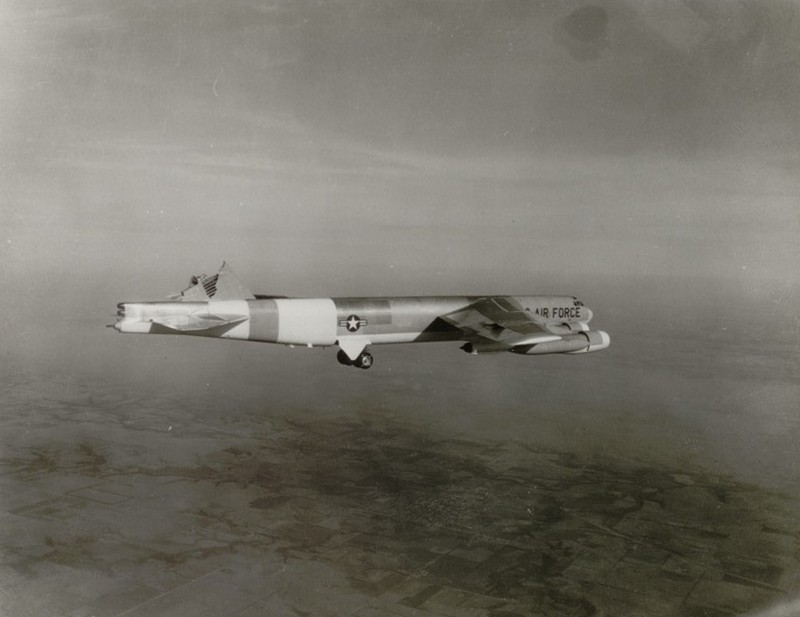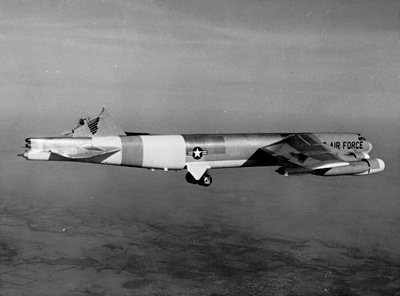B-52
B-52
Just come across this amazing tribute to the B-52 (and a superb team effort) in another forum:
January 10, 1964, started out as a typical day for the flight test group at Boeing's Wichita plant. Pilot Chuck Fisher took off in a B-52H with a three-man Boeing crew, flying a low-level profile to obtain structural data.
Over Colorado, cruising 500 feet above the mountainous terrain, the B-52 encountered some turbulence. Fisher climbed to 14,300 feet looking for smoother air. At this point the typical day ended.The bomber flew into clear-air turbulence. It felt as if the plane had been placed in a giant high-speed elevator, shoved up and down, and hit by a heavy blow on its right side.
Fisher told the crew to prepare to abandon the plane. He slowed the aircraft and dropped to about 5,000 feet to make it easier to bail out. But then Fisher regained some control. He climbed slowly to 16,000 feet to put some safety room between the plane and the ground. He informed Wichita about what was happening. Although control was difficult, Fisher said he believed he could get the plane back in one piece.
Response to the situation at Wichita, and elsewhere, was immediate. An emergency control center was set up in the office of Wichita's director of flight test. Key Boeing engineers and other specialists were summoned to provide their expertise. Federal Aviation Administration air traffic control centers at Denver and Kansas City cleared the air around the troubled plane. A Strategic Air Command B-52 in the area maintained radio contact with the crew of the Wichita B-52.
As Fisher got closer to Wichita, a Boeing chase plane flew up to meet him and to visually report the damage. When Dale Felix, flying an F-100 fighter, came alongside Fisher's B-52, he couldn't believe what he saw: The B-52's vertical tail was gone.
Felix broke the news to Fisher and those gathered in the control center. There was no panic. Everyone on the plane and in the control center knew they could be called upon at any time for just such a situation. In the emergency control center, the engineers began making calculations and suggesting the best way to get the plane down safely. The Air Force was also lending assistance. A B-52, just taking off for a routine flight, was used to test the various flight configurations suggested by the specialists before Fisher had to try them.
As high gusty winds rolled into Wichita, the decision was made to divert the B-52 to Blytheville Air Force Base in Northeastern Arkansas. Boeing specialists from the emergency control center took off in a KC-135 and accompanied Fisher to Blytheville, serving as an airborne control center.
Six hours after the incident first occurred, Fisher and his crew brought in the damaged B-52 for a safe landing.
"I'm very proud of this crew and this airplane," Fisher said. "Also we had a lot people helping us, and we're very thankful for that." The B-52, Fisher said, "Is the finest airplane I ever flew."

January 10, 1964, started out as a typical day for the flight test group at Boeing's Wichita plant. Pilot Chuck Fisher took off in a B-52H with a three-man Boeing crew, flying a low-level profile to obtain structural data.
Over Colorado, cruising 500 feet above the mountainous terrain, the B-52 encountered some turbulence. Fisher climbed to 14,300 feet looking for smoother air. At this point the typical day ended.The bomber flew into clear-air turbulence. It felt as if the plane had been placed in a giant high-speed elevator, shoved up and down, and hit by a heavy blow on its right side.
Fisher told the crew to prepare to abandon the plane. He slowed the aircraft and dropped to about 5,000 feet to make it easier to bail out. But then Fisher regained some control. He climbed slowly to 16,000 feet to put some safety room between the plane and the ground. He informed Wichita about what was happening. Although control was difficult, Fisher said he believed he could get the plane back in one piece.
Response to the situation at Wichita, and elsewhere, was immediate. An emergency control center was set up in the office of Wichita's director of flight test. Key Boeing engineers and other specialists were summoned to provide their expertise. Federal Aviation Administration air traffic control centers at Denver and Kansas City cleared the air around the troubled plane. A Strategic Air Command B-52 in the area maintained radio contact with the crew of the Wichita B-52.
As Fisher got closer to Wichita, a Boeing chase plane flew up to meet him and to visually report the damage. When Dale Felix, flying an F-100 fighter, came alongside Fisher's B-52, he couldn't believe what he saw: The B-52's vertical tail was gone.
Felix broke the news to Fisher and those gathered in the control center. There was no panic. Everyone on the plane and in the control center knew they could be called upon at any time for just such a situation. In the emergency control center, the engineers began making calculations and suggesting the best way to get the plane down safely. The Air Force was also lending assistance. A B-52, just taking off for a routine flight, was used to test the various flight configurations suggested by the specialists before Fisher had to try them.
As high gusty winds rolled into Wichita, the decision was made to divert the B-52 to Blytheville Air Force Base in Northeastern Arkansas. Boeing specialists from the emergency control center took off in a KC-135 and accompanied Fisher to Blytheville, serving as an airborne control center.
Six hours after the incident first occurred, Fisher and his crew brought in the damaged B-52 for a safe landing.
"I'm very proud of this crew and this airplane," Fisher said. "Also we had a lot people helping us, and we're very thankful for that." The B-52, Fisher said, "Is the finest airplane I ever flew."

Join Date: May 2007
Location: Castlegar
Posts: 255
Likes: 0
Received 0 Likes
on
0 Posts
Good photo. Other accounts --
I hadn't read that account of the 10Jan64 VertStab failure -- could you cite the source (eg, magazine /date)?

Other more formal accounts were released after the BOAC B707 G-APFE / 5Mar66 investigation (odd since the USAF generally won't offer "analysis" for public reports describing their mishaps). Another interesting coincidence was the LOCATION of the mishap (downwind of Spanish Peaks), later NTSB found _pilots_ of a civil airliner as cause for a turbulence mishap near that same location (A320/ 19Apr01 rpt tags location as "Raton" with unusual P.C. because Board generally treated turb-injuries as an act of God)
Here's an early pilot’s account of the B-52 that suffered fracture & separation of its Vert’ Stab’ from Boeing memorandum dated Jan 28’64:

Other more formal accounts were released after the BOAC B707 G-APFE / 5Mar66 investigation (odd since the USAF generally won't offer "analysis" for public reports describing their mishaps). Another interesting coincidence was the LOCATION of the mishap (downwind of Spanish Peaks), later NTSB found _pilots_ of a civil airliner as cause for a turbulence mishap near that same location (A320/ 19Apr01 rpt tags location as "Raton" with unusual P.C. because Board generally treated turb-injuries as an act of God)
Here's an early pilot’s account of the B-52 that suffered fracture & separation of its Vert’ Stab’ from Boeing memorandum dated Jan 28’64:
“… flown trough an area containing the combined effects of a rotor associated with a mountain wave and lateral shear due to airflow around a large peak…. Gust initially built up from the right to a maximum of about 45 feet per second (TAS), then reversed to a maximum of 36 feet per second from the left, before swinging … to a maximum of about 147 feet per second … from the left … followed by a return to 31 feet per second …”
Her's an excerpt from _Aerospace Safety_, April’64: “As the encounter progressed … a very sharp- edged blow which was followed by many more…. We developed an almost instantaneous rate of roll at fairly high rate. The roll was to the far left and the nose was swinging up and to the right at a rapid rate. During the second portion of the encounter, the airplane motions actually seemed to be negating my control inputs. I had the rudder to the firewall, the column in my lap, and full wheel, and I wasn’t having any luck righting the airplane….”
Last edited by IGh; 12th May 2014 at 14:50. Reason: re-post photo (earlier dead-link now gone)




